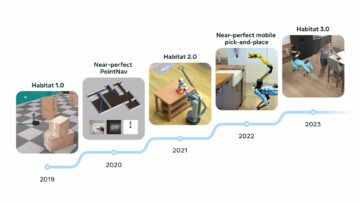Shared learning is about individuals working together, exchanging knowledge and insights, to achieve remarkable results. It goes beyond traditional learning, tapping into the power of collaboration. By joining forces, agents can overcome challenges that would be difficult for them to tackle individually.
Consider the potential when diverse machines come together, each contributing its unique expertise. Shared learning models collaborate in unprecedented ways, surpassing the limitations of individual machines. Through these collaborations, they unlock new insights, optimize decision-making, and pioneer innovative solutions.
Shared learning models learn from vast and diverse datasets, enhancing their predictive abilities with remarkable accuracy. This breakthrough impacts various fields such as healthcare, finance, transportation, and more. It drives scientific progress, uncovering hidden patterns and propelling us toward groundbreaking discoveries.
But shared learning is not just about machines, it empowers humanity. By embracing collaboration and collective intelligence, we unlock the boundless potential of shared knowledge. This approach impacts personalized experiences, decision-making, and the creation of a sustainable future.

What is shared learning?
Shared learning in machine learning refers to a collaborative learning approach where multiple models or agents work together to improve their individual performances. Instead of training a single model in isolation, shared learning involves sharing knowledge, insights, or data among multiple models or agents to enhance their overall learning capabilities.
In shared learning, models can communicate and exchange information through various means, such as sharing model parameters, gradients, predictions, or even raw data samples. This collaboration enables models to leverage diverse perspectives, learn from different experiences, and collectively benefit from the knowledge gained by the entire group.
There are different paradigms of shared learning, including:
- Federated learning: In federated learning, multiple devices or entities collectively train a shared model without sharing their raw data. Each device performs local training on its own data, and only the updated model parameters are exchanged and aggregated by a central server or coordinator. This approach preserves data privacy while allowing models to learn from a large distributed dataset.
- Multi-agent reinforcement learning: In multi-agent reinforcement learning, multiple agents interact with an environment and learn from their experiences. They can communicate and share information, such as policies or value estimates, to improve their decision-making abilities. This approach is often used in scenarios where multiple autonomous agents need to collaborate or compete to achieve common goals.
- Knowledge distillation: Knowledge distillation involves training a large “teacher” model and then using it to teach a smaller “student” model. The teacher model’s knowledge is transferred to the student model by either training the student on the teacher’s predictions or by using the teacher’s internal representations as additional supervision. This approach helps the student model benefit from the knowledge and generalization abilities of the larger model.
The term “shared learning” is commonly used in the context of machine learning and artificial intelligence, but the underlying concept of collaborative learning can be found in various domains beyond machine learning.
In the context of machine learning, shared learning techniques are specifically designed to improve the performance and capabilities of models by leveraging collaboration and knowledge exchange between multiple agents or models. These techniques take advantage of the distributed nature of data, expertise, or computation to enhance learning outcomes.
However, collaborative learning is a broader concept that can be applied in other fields as well. For example, in education, collaborative or shared learning refers to an instructional approach where students work together in groups to solve problems, discuss ideas, and learn from each other’s perspectives. This approach promotes active learning, teamwork, and knowledge sharing among students.

Shared learning offers many benefits
Shared learning models in machine learning have numerous benefits that contribute to their widespread use. One advantage is the improved performance they offer. By allowing models to share knowledge, insights, or data, shared learning enables them to learn from a larger and more diverse range of experiences. This collaboration among models leads to enhanced accuracy, better predictive power, and improved decision-making abilities.
Another benefit of shared learning is the faster convergence it provides. Instead of starting from scratch, models can build upon the progress made by their peers. This means they can learn more quickly and reach higher performance levels in less time. This is particularly valuable in situations where there is limited data availability or restricted training resources.
Shared learning also promotes robustness and generalization in machine learning models. By exposing models to a broader range of experiences and perspectives, they become more adaptable and better able to handle variations, noise, or biases that may be present in individual datasets. This broader exposure helps models generalize well, ensuring their effectiveness in real-world scenarios.
Privacy-preserving learning is another significant advantage of shared learning. Techniques like federated learning enable collaborative learning while respecting data privacy. Instead of sharing raw data, models exchange only model updates or aggregated statistics. This ensures that individual data remains confidential while allowing models to learn from a distributed dataset, making shared learning suitable for applications involving sensitive or proprietary data.
Shared learning also contributes to scalability and resource efficiency. By distributing the computational workload across multiple models or agents, shared learning reduces the overall computational requirements. This approach optimizes resource utilization and allows models to leverage local resources for training. Additionally, as the number of models increases, shared learning can scale effectively, enabling efficient parallelization and resource utilization.

Machine learning is the technology that will shape the future
Machine learning models offer a promising future with a wide range of possibilities that can transform our lives. One key aspect is automation and efficiency. These models can automate repetitive tasks, optimize resource allocation, and streamline processes, resulting in increased productivity and cost savings. From manufacturing to customer service, machine learning models can revolutionize how work is done, making it more efficient and error-free.
Another exciting prospect is personalized experiences. Machine learning models can analyze vast amounts of data and understand individual preferences, allowing them to deliver tailored recommendations, treatment plans, learning paths, and entertainment content. This personalization enhances user satisfaction and engagement, ensuring that people receive the experiences that best suit their needs and preferences.
Machine learning models also contribute to improved decision-making. By analyzing large datasets, detecting patterns, and making predictions or recommendations, these models can assist professionals in making data-driven decisions. In sectors like finance, healthcare, and transportation, machine learning models can aid in mitigating risks, optimizing outcomes, and improving overall decision-making processes.
Efficiency and resource management are other areas where machine learning models excel. By optimizing resource utilization and reducing waste, these models have the potential to transform sectors such as energy management, logistics, supply chain management, and agriculture. They can analyze consumption patterns, predict demand, and optimize distribution, leading to more efficient resource use and reduced environmental impact.
As for healthcare, machine learning models hold great promise. They can aid in early disease detection, personalized treatment plans, drug discovery, and precision medicine. By analyzing patient data, genetic information, and medical research, these models can assist healthcare professionals in making accurate diagnoses and improving patient outcomes, revolutionizing the field of healthcare.
While embracing the potential of machine learning models, it is essential to address ethical considerations. Ensuring fairness, transparency, and accountability in algorithmic decision-making is crucial. By identifying and mitigating potential biases, we can ensure that the benefits of machine learning are distributed equitably and that decisions made by these models are ethical and aligned with societal values.

How to implement shared learning methods in machine learning
Implementing shared learning methods in machine learning can be illustrated through real-life examples, showcasing how collaboration and knowledge exchange can bring about significant benefits:
One example is in the healthcare domain. Imagine a scenario where hospitals collaborate to train a shared model for disease prediction. Each hospital has its own dataset containing patient records, but due to privacy concerns, it cannot directly share the data. Instead, they adopt federated learning, where local models are trained on their respective datasets, and only the model updates or aggregated statistics are shared. By collaboratively learning from a diverse range of patient data while maintaining privacy, the shared model becomes more accurate in predicting diseases and can assist doctors in making better diagnoses.
How is artificial intelligence in surgery and healthcare changing our lives?
Another example lies in autonomous driving. Multiple self-driving cars can engage in multi-agent reinforcement learning to learn safe and efficient driving behaviors. Each car interacts with the environment, gathers experiences, and shares them with other cars in the network. By learning from each other’s experiences and policies, the shared learning models can collectively improve their driving skills, navigate complex scenarios, and enhance overall road safety.
In education, shared learning can be seen in collaborative learning environments. Students work together in groups to solve problems, discuss concepts, and learn from each other’s perspectives. By sharing knowledge, insights, and different problem-solving approaches, students collectively deepen their understanding, develop critical thinking skills, and improve their learning outcomes. This collaborative learning approach fosters engagement, teamwork, and active participation, ultimately enhancing the overall educational experience.
In the business sector, knowledge distillation is commonly employed. Imagine a scenario where a large deep-learning model has been trained on a vast amount of data to achieve high accuracy. To deploy this model on resource-constrained devices, such as smartphones, knowledge distillation is used. The large model acts as a “teacher” by sharing its knowledge and predictions with a smaller “student” model. The student model learns from the teacher’s insights, enabling it to perform at a similar level of accuracy but with reduced computational and memory requirements, making it suitable for deployment on devices with limited resources.
These real-life examples highlight how shared learning methods can be applied in various domains to achieve improved performance, accelerated learning, enhanced decision-making, and knowledge transfer.
By utilizing collaboration and collective intelligence, shared learning empowers models or agents to achieve better outcomes and address complex challenges more effectively.
Featured image credit: Pixabay on Pexels.
- SEO Powered Content & PR Distribution. Get Amplified Today.
- PlatoData.Network Vertical Generative Ai. Empower Yourself. Access Here.
- PlatoAiStream. Web3 Intelligence. Knowledge Amplified. Access Here.
- PlatoESG. Automotive / EVs, Carbon, CleanTech, Energy, Environment, Solar, Waste Management. Access Here.
- BlockOffsets. Modernizing Environmental Offset Ownership. Access Here.
- Source: https://dataconomy.com/2023/07/17/shared-learning-peer-to-peer-learning/
- :has
- :is
- :not
- :where
- 1
- a
- abilities
- Able
- About
- accelerated
- accountability
- accuracy
- accurate
- Achieve
- across
- active
- acts
- Additional
- Additionally
- address
- adopt
- ADvantage
- agents
- agriculture
- Aid
- algorithmic
- aligned
- allocation
- Allowing
- allows
- also
- among
- amount
- amounts
- an
- analyze
- analyzing
- and
- Another
- applications
- applied
- approach
- approaches
- ARE
- areas
- artificial
- artificial intelligence
- AS
- aspect
- assist
- assisting
- At
- automate
- Automation
- autonomous
- availability
- BE
- become
- becomes
- been
- behaviors
- benefit
- benefits
- BEST
- Better
- between
- Beyond
- biases
- Boundless
- breakthrough
- bring
- broader
- build
- but
- by
- CAN
- cannot
- capabilities
- car
- cars
- central
- chain
- challenges
- changing
- collaborate
- collaboration
- collaborations
- collaborative
- Collective
- collectively
- come
- Common
- commonly
- communicate
- compete
- complex
- computation
- concept
- concepts
- Concerns
- considerations
- consumption
- content
- context
- contribute
- contributes
- contributing
- Convergence
- Coordinator
- Cost
- cost savings
- creation
- credit
- critical
- crucial
- customer
- Customer Service
- data
- data privacy
- data-driven
- datasets
- Decision Making
- decisions
- Deepen
- deliver
- Demand
- deploy
- deployment
- designed
- Detection
- develop
- device
- Devices
- different
- difficult
- directly
- discovery
- discuss
- Disease
- diseases
- distributed
- distributing
- distribution
- diverse
- diverse perspectives
- Doctors
- domains
- done
- drives
- driving
- drug
- drug discovery
- due
- each
- Early
- Education
- educational
- effectively
- effectiveness
- efficiency
- efficient
- either
- embracing
- employed
- empowers
- enable
- enables
- enabling
- energy
- engage
- engagement
- enhance
- enhanced
- Enhances
- enhancing
- ensure
- ensures
- ensuring
- Entertainment
- Entire
- entities
- Environment
- environmental
- essential
- estimates
- ethical
- Even
- example
- examples
- Excel
- exchange
- exchanged
- exchanging
- exciting
- experience
- Experiences
- expertise
- Exposure
- fairness
- faster
- field
- Fields
- finance
- For
- Forces
- fosters
- found
- from
- future
- gained
- Goals
- Goes
- gradients
- great
- groundbreaking
- Group
- Group’s
- handle
- Have
- healthcare
- helps
- Hidden
- High
- higher
- Highlight
- hold
- Hospital
- hospitals
- How
- HTTPS
- Humanity
- ideas
- identifying
- image
- imagine
- Impact
- Impacts
- implement
- improve
- improved
- improving
- in
- In other
- Including
- increased
- Increases
- individual
- Individually
- individuals
- information
- innovative
- insights
- instead
- instructional
- Intelligence
- interact
- interacts
- internal
- into
- involves
- involving
- isolation
- IT
- ITS
- joining
- jpg
- just
- Key
- knowledge
- knowledge transfer
- large
- larger
- leading
- Leads
- LEARN
- learning
- less
- Level
- levels
- Leverage
- leveraging
- lies
- like
- limitations
- Limited
- Lives
- local
- logistics
- machine
- machine learning
- Machines
- made
- maintaining
- Making
- management
- manufacturing
- many
- max-width
- May..
- means
- medical
- medical research
- medicine
- Memory
- methods
- mitigating
- mitigating risks
- model
- models
- more
- more efficient
- multiple
- Nature
- Navigate
- Need
- needs
- network
- New
- Noise
- number
- numerous
- numerous benefits
- of
- offer
- Offers
- often
- on
- ONE
- only
- Optimize
- Optimizes
- optimizing
- or
- Other
- our
- outcomes
- overall
- Overcome
- own
- parameters
- participation
- particularly
- patient
- patient data
- patterns
- People
- perform
- performance
- performances
- performs
- personalization
- Personalized
- perspectives
- pioneer
- planning
- plans
- plato
- Plato Data Intelligence
- PlatoData
- policies
- possibilities
- potential
- power
- Precision
- predict
- predicting
- prediction
- Predictions
- preferences
- present
- privacy
- problem-solving
- problems
- processes
- productivity
- professionals
- Progress
- promise
- promising
- promotes
- propelling
- proprietary
- prospect
- provides
- quickly
- range
- Raw
- raw data
- reach
- real world
- receive
- recommendations
- records
- Reduced
- reduces
- reducing
- refers
- reinforcement learning
- remains
- remarkable
- repetitive
- Requirements
- research
- resource
- Resources
- respecting
- respective
- restricted
- resulting
- Results
- revolutionize
- Revolutionizing
- risks
- road
- road safety
- safe
- Safety
- satisfaction
- Savings
- Scale
- scenario
- scenarios
- scientific
- scratch
- Sectors
- seen
- self-driving
- sensitive
- service
- Shape
- Share
- shared
- Shares
- sharing
- showcasing
- significant
- similar
- single
- situations
- skills
- smaller
- smartphones
- societal
- Solutions
- SOLVE
- Sparks
- specifically
- Starting
- statistics
- streamline
- Student
- Students
- such
- Suit
- suitable
- supervision
- supply
- supply chain
- supply chain management
- Surgery
- sustainable
- sustainable future
- tackle
- tailored
- Take
- tapping
- tasks
- teacher
- teamwork
- techniques
- Technology
- term
- that
- The
- their
- Them
- then
- There.
- These
- they
- Thinking
- this
- Through
- time
- to
- together
- toward
- traditional
- Train
- trained
- Training
- transfer
- transferred
- Transform
- Transparency
- transportation
- treatment
- Ultimately
- underlying
- understand
- understanding
- unique
- unlock
- unprecedented
- updated
- Updates
- upon
- us
- use
- used
- User
- using
- Utilizing
- Valuable
- value
- Values
- various
- Vast
- Waste
- ways
- we
- WELL
- when
- while
- wide
- Wide range
- widespread
- will
- with
- without
- Work
- work together
- working
- would
- zephyrnet












